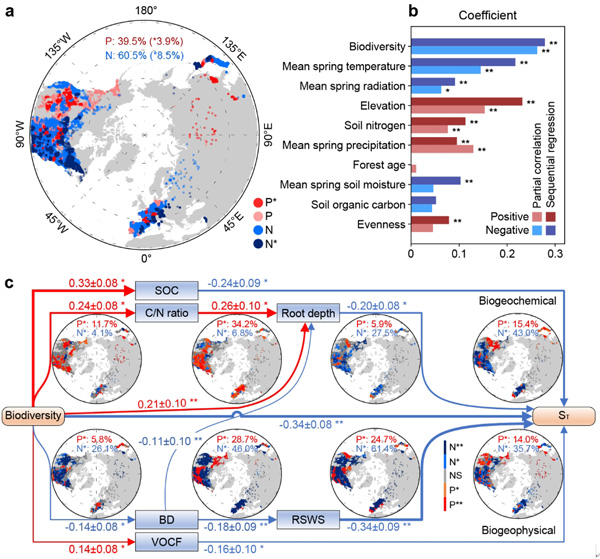Researchers Find Biodiversity Buffers the Response of Vegetation Spring Phenology to Warming
Understanding the sensitivity of spring leaf-out dates to temperature (ST) is integral to predicting phenological responses to climate warming and the consequences for global biogeochemical cycles. While variation in ST has been shown to be influenced by local climate adaptations, the impact of biodiversity remains unknown. Previous studies have shown that biodiversity can stabilize vegetation phenology, thereby contributing to the overall stability of ecosystem functions.
Prof. WU Chaoyang's team at the Institute of Geographic Sciences and Natural Resources Research of the Chinese Academy of Sciences, along with collaborators, studied the relationship between biodiversity with the response of vegetation spring phenology to global warming using data from 393,139 forest inventory plots. This research was published in Nature Climate Change.
Under the guidance of Prof. WU and Associate Prof. WANG Xiaoyue, doctoral student SHEN Pengju discovered that biodiversity has a strong direct impact on ST. ST is lower in forests with higher biodiversity, which can be attributed to the seasonal asynchrony and diversity of responses across different species.
The team found that biodiversity reduces ST by improving biogeophysical and biogeochemical factors simultaneously and influences the spatial variation of ST across the Northern Hemisphere, with its impact even exceeding that of climate factors.
“ST act as an indicator for predicting phenological responses to climate warming and its effects on global biogeochemical cycles. We quantified the response of vegetation spring phenology to climate change using ST,” said associate Prof. WANG Xiaoyue.
“ST is the optimal strategy evolved by vegetation under the selection pressure of the local historical climate environment. Its variations reflect the adaptive adjustments made by vegetation to optimize their life cycle in response to climate change,” Prof. Wu added.
They revealed that plots with higher biodiversity tend to have deeper root systems, which may help vegetation obtain soil nutrients and water in spring. The enhanced supply of water and nutrients may, in turn, reduce the trees' dependence on temperature in the early growing season.
The results highlight the necessity of incorporating biodiversity's buffering effect on ST in predicting climate change impacts on phenology and ecosystems. Neglecting this factor may lead to inaccurate phenological simulations, affecting the Earth system models’ description of ecosystem functions.

Reference:
Download attachments: